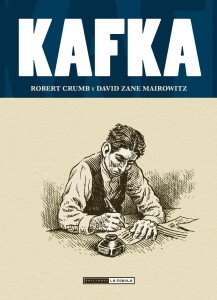 First time I heard of Franz Kafka was when I read the liner notes to the Mothers of Invention album We’re Only In It For the Money. The one with the Sgt. Pepper parody cover! One track was entitled “The Chrome Plated Megaphone of Destiny” and Zappa’s notes recommended reading Franz Kafka’s In the Penal Colony before listening. So I trudged off to the local book shop and bought a copy. It included another weird story called Metamorphosis. Reading Kafka’s tales of internal terror was just the ticket for my teenaged angst, and helped me to find myself. Til then, I hadn’t even realized I was lost!
First time I heard of Franz Kafka was when I read the liner notes to the Mothers of Invention album We’re Only In It For the Money. The one with the Sgt. Pepper parody cover! One track was entitled “The Chrome Plated Megaphone of Destiny” and Zappa’s notes recommended reading Franz Kafka’s In the Penal Colony before listening. So I trudged off to the local book shop and bought a copy. It included another weird story called Metamorphosis. Reading Kafka’s tales of internal terror was just the ticket for my teenaged angst, and helped me to find myself. Til then, I hadn’t even realized I was lost!
Kafka is a concise look at the Czech writer’s life and work. Robert Crumb provides the illustrations while David Mairowitz tells the story in text. The text is well-informed and blends biography with Kafka’s literary work, placed in context. This is a clever and eminently workable format. Especially if you believe, as these collaborators do, that Kafka’s fictions were images of his own life. The illustrations provided by Crumb are in his unique style, rich black ink against crisp white, moving seemlessly from lifelike representation to surrealist imagery, and also utilizing echoes from the German Expressionists (especially George Grosz). The women take on the size and voluptuousness of Crumb’s usual vision, which adds to Kafka’s alienation from the female of the species.
One senses a real connection between the artist Crumb and the writer Kafka. This is enhanced by a viewing of the film Crumb, which should not be missed. Mairowitz, an American writer living in Britain, has written many radio plays and has an easy, almost intimate style, which conveys the sad life of Franz Kafka quite convincingly. The hook, on which Mairowitz hangs his tale, is the development of Kafka from person to adjective. “Kafkaesque” has taken on a mystical, and very broad definition far beyond what the original works probably intended.
Of course the best thing to do to come to know Kafka would be to buy a collection of his works and read him for yourself, maybe while listening to “The Chrome Plated Megaphone of Destiny.” But if you want a quicker entrance into his world, and some ammunition for cocktail party chats, Mairowitz’s and Crumb’s short volume is just the ticket!
(Fantagraphics Books, 2007)
